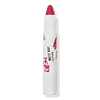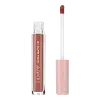What's inside
What's inside
 Key Ingredients
Key Ingredients

 Benefits
Benefits

 Concerns
Concerns

 Ingredients Side-by-side
Ingredients Side-by-side

Isododecane
EmollientDimethicone
EmollientOctyldodecanol
EmollientSynthetic Beeswax
Emulsion StabilisingSynthetic Wax
AbrasiveTrimethylsiloxysilicate
EmollientVinyl Dimethicone/Methicone Silsesquioxane Crosspolymer
Silica
AbrasiveOzokerite
Emulsion StabilisingC10-18 Triglycerides
EmollientDiisostearyl Malate
EmollientLauroyl Lysine
Skin ConditioningAluminum Hydroxide
EmollientOryza Sativa Bran Extract
Skin ConditioningLecithin
EmollientPhenoxyethanol
PreservativeButyrospermum Parkii Butter
Skin ConditioningTocopherol
AntioxidantCaprylyl Glycol
EmollientHelianthus Annuus Extract
EmollientEthylhexylglycerin
Skin ConditioningHexylene Glycol
EmulsifyingRosmarinus Officinalis Leaf Extract
AntimicrobialFragaria Vesca Seed Oil
EmollientPrunus Armeniaca Kernel Oil
MaskingRubus Idaeus Seed Oil
EmollientSambucus Nigra Seed Oil
CI 77120
Cosmetic ColorantCI 77891
Cosmetic ColorantCI 77492
Cosmetic ColorantCI 15850
Cosmetic ColorantCI 42090
Cosmetic ColorantCI 45410
Cosmetic ColorantCI 73360
Cosmetic ColorantIsododecane, Dimethicone, Octyldodecanol, Synthetic Beeswax, Synthetic Wax, Trimethylsiloxysilicate, Vinyl Dimethicone/Methicone Silsesquioxane Crosspolymer, Silica, Ozokerite, C10-18 Triglycerides, Diisostearyl Malate, Lauroyl Lysine, Aluminum Hydroxide, Oryza Sativa Bran Extract, Lecithin, Phenoxyethanol, Butyrospermum Parkii Butter, Tocopherol, Caprylyl Glycol, Helianthus Annuus Extract, Ethylhexylglycerin, Hexylene Glycol, Rosmarinus Officinalis Leaf Extract, Fragaria Vesca Seed Oil, Prunus Armeniaca Kernel Oil, Rubus Idaeus Seed Oil, Sambucus Nigra Seed Oil, CI 77120, CI 77891, CI 77492, CI 15850, CI 42090, CI 45410, CI 73360
Isododecane
EmollientAlumina
AbrasiveDiisostearyl Malate
EmollientTrimethylsiloxysilicate
EmollientDiisopropyl Dimer Dilinoleate
EmollientIsohexadecane
EmollientHydrated Silica
AbrasiveDisteardimonium Hectorite
StabilisingOctyldodecanol
EmollientCitrus Aurantium Dulcis Peel Extract
Emulsion StabilisingCitrus Grandis Peel Extract
AstringentCitrus Junos Peel Extract
Skin ConditioningCitrus Clementina Fruit Extract
Skin ConditioningCucumis Melo Cantalupensis Fruit Extract
AstringentHedychium Spicatum Extract
Skin ConditioningCitrus Tangerina Peel Extract
AstringentLavandula Angustifolia Flower/Leaf/Stem Extract
MaskingVanilla Planifolia Fruit Extract
Skin ConditioningZingiber Officinale Root Extract
MaskingTocopherol
AntioxidantPropylene Carbonate
SolventEthylene/Propylene/Styrene Copolymer
Diethylhexyl Syringylidenemalonate
Skin ProtectingDibutyl Lauroyl Glutamide
Skin ConditioningDibutyl Ethylhexanoyl Glutamide
Skin ConditioningAroma
Hydrogenated Polydicyclopentadiene
Caprylic/Capric Triglyceride
MaskingPhenoxyethanol
PreservativeTerminalia Ferdinandiana Seed Oil
AntioxidantPrunus Avium Seed Oil
EmollientRhus Verniciflua Peel Wax
Caprylyl Glycol
EmollientButylene/Ethylene/Styrene Copolymer
Ethylhexylglycerin
Skin ConditioningHexylene Glycol
EmulsifyingPentaerythrityl Tetra-Di-T-Butyl Hydroxyhydrocinnamate
AntioxidantC10-18 Triglycerides
EmollientTriethoxycaprylylsilane
Silica
AbrasiveAluminum Hydroxide
EmollientIsopropyl Titanium Triisostearate
EmollientBis-PEG-15 Dimethicone/Ipdi Copolymer
PEG-2 Soyamine
EmulsifyingCI 77266
Cosmetic ColorantCI 77163
Cosmetic ColorantCI 42090
Cosmetic ColorantCI 77400
Cosmetic ColorantIron Oxides
CI 77742
Cosmetic ColorantMica
Cosmetic ColorantCI 15850
Cosmetic ColorantCI 45380
Cosmetic ColorantCI 45410
Cosmetic ColorantCI 73360
Cosmetic ColorantCI 16035
Cosmetic ColorantCI 77891
Cosmetic ColorantCI 19140
Cosmetic ColorantIsododecane, Alumina, Diisostearyl Malate, Trimethylsiloxysilicate, Diisopropyl Dimer Dilinoleate, Isohexadecane, Hydrated Silica, Disteardimonium Hectorite, Octyldodecanol, Citrus Aurantium Dulcis Peel Extract, Citrus Grandis Peel Extract, Citrus Junos Peel Extract, Citrus Clementina Fruit Extract, Cucumis Melo Cantalupensis Fruit Extract, Hedychium Spicatum Extract, Citrus Tangerina Peel Extract, Lavandula Angustifolia Flower/Leaf/Stem Extract, Vanilla Planifolia Fruit Extract, Zingiber Officinale Root Extract, Tocopherol, Propylene Carbonate, Ethylene/Propylene/Styrene Copolymer, Diethylhexyl Syringylidenemalonate, Dibutyl Lauroyl Glutamide, Dibutyl Ethylhexanoyl Glutamide, Aroma, Hydrogenated Polydicyclopentadiene, Caprylic/Capric Triglyceride, Phenoxyethanol, Terminalia Ferdinandiana Seed Oil, Prunus Avium Seed Oil, Rhus Verniciflua Peel Wax, Caprylyl Glycol, Butylene/Ethylene/Styrene Copolymer, Ethylhexylglycerin, Hexylene Glycol, Pentaerythrityl Tetra-Di-T-Butyl Hydroxyhydrocinnamate, C10-18 Triglycerides, Triethoxycaprylylsilane, Silica, Aluminum Hydroxide, Isopropyl Titanium Triisostearate, Bis-PEG-15 Dimethicone/Ipdi Copolymer, PEG-2 Soyamine, CI 77266, CI 77163, CI 42090, CI 77400, Iron Oxides, CI 77742, Mica, CI 15850, CI 45380, CI 45410, CI 73360, CI 16035, CI 77891, CI 19140
Ingredients Explained
These ingredients are found in both products.
Ingredients higher up in an ingredient list are typically present in a larger amount.
Aluminum Hydroxide is a form of aluminum. It can be naturally found in nature as the mineral gibbsite. In cosmetics, Aluminum Hydroxide is used as a colorant, pH adjuster, and absorbent.
As a colorant, Aluminum Hydroxide may add opacity, or reduce the transparency. Aluminum hydroxide is contains both basic and acidic properties.
According to manufacturers, this ingredient is an emollient and humectant. This means it helps hydrate the skin.
In medicine, this ingredient is used to help relieve heartburn and help heal ulcers.
There is currently no credible scientific evidence linking aluminum hydroxide in cosmetics to increased cancer risk.
Major health organizations allow the use of aluminum hydroxide in personal care products and have not flagged it as a carcinogenic risk at typical usage levels.
Learn more about Aluminum HydroxideC10-18 Triglycerides is a skin conditioning and texture-enhancer.
It is created from glycerin and a mixture of C10-18 fatty acids.
This ingredient improves spreadability and helps thicken a product.
According to manufacturers, it usually comes from vegetable-based saturated fatty acids. Common bases for this ingredient are coconut oil, palm kernel oil, or both.
Due to the melting point being close to skin temperature, it is usually used in lip products.
Triglycerides are a main component of fat in the human body.
Learn more about C10-18 TriglyceridesCaprylyl Glycol is a humectant and emollient, meaning it attracts and preserves moisture.
It is a common ingredient in many products, especially those designed to hydrate skin. The primary benefits are retaining moisture, skin softening, and promoting a healthy skin barrier.
Though Caprylyl Glycol is an alcohol derived from fatty acids, it is not the kind that can dry out skin.
This ingredient is also used as a preservative to extend the life of products. It has slight antimicrobial properties.
Learn more about Caprylyl GlycolCi 15850 is the pigment color red. It is an azo dye and created synthetically.
Azo dyes need to be thoroughly purified before use. This allows them to be more stable and longer-lasting.
This ingredient is common in foundations, lipsticks, and blushes. This color is described as brown/orangey red.
It has many secondary names such as Red 6 and Red 7. According to a manufacturer, Red 6 usually contains aluminum.
Learn more about CI 15850Ci 42090 is a synthetic dye created from petroleum. It is used to give a bright blue color to cosmetics, medicine, and food.
CI 45410 is a synthetic red-pigment and dye.
It often goes by both Red 28 or Red 27; manufacturers label both ingredients as CI 45410.
This dye is commonly found in makeup because it imparts a vivid color. Some types of this dye change color based on pH level and interaction with moisture:
Your skin has a natural pH of around 4.5 - 5.5.
According to the FDA, CI 45410 is not permitted for use in eye products.
Red 27 is a flourescein dye and commonly used as a fluorescent tracer in medicine.
Learn more about CI 45410Ci 73360 is a synthetic red-pink dye.
Ci 77891 is a white pigment from Titanium dioxide. It is naturally found in minerals such as rutile and ilmenite.
It's main function is to add a white color to cosmetics. It can also be mixed with other colors to create different shades.
Ci 77891 is commonly found in sunscreens due to its ability to block UV rays.
Learn more about CI 77891Diisostearyl Malate is an emollient and most often used in lip products. It comes from isostearyl alcohol, a fatty acid, and malic acid, an AHA.
As an emollient, Diisostearyl Malate helps create a thin film on your skin to trap moisture in. This helps keep your skin soft and smooth.
Ethylhexylglycerin (we can't pronounce this either) is commonly used as a preservative and skin softener. It is derived from glyceryl.
You might see Ethylhexylglycerin often paired with other preservatives such as phenoxyethanol. Ethylhexylglycerin has been found to increase the effectiveness of these other preservatives.
Hexylene Glycol is a surfactant. Glycols are a class of alcohols. Hexylene Glycol is a surfactant and emulsifier.
As a surfactant, Hexylene Glycol helps gather dirt and oil on your skin to be washed away.
As an emulsifier, Hexylene Glycol helps keep water and oil together. This prevents them from separating in a product. Hexylene Glycol also thins out the texture of a product by lessening viscosity.
Hexylene Glycol has a small molecular weight.
Learn more about Hexylene GlycolIsododecane is a fragrance, emollient, and solvent.
As an emollient, it helps your skin stay soft and hydrated. Emollients help trap moisture into your skin.
Isododecane's role as a solvent makes it a great texture enhancer. It spreads smoothly on skin and does not leave a sticky feeling behind. Isododecane also helps prevent color transfer in makeup products.
Isododecane is not absorbed into skin.
Learn more about IsododecaneOctyldodecanol is a fatty alcohol. It is primarily used to enhance the texture of products.
As an emulsifier, Octyldodecanol helps prevent the oils and waters from separating. It also prevents ingredients from creating foam when shaken.
Octyldodecanol is created by reducing fatty acid to an alcohol.
Due to its high molecular weight, it does not get absorbed into the skin.
Learn more about OctyldodecanolPhenoxyethanol is a preservative that has germicide, antimicrobial, and aromatic properties. Studies show that phenoxyethanol can prevent microbial growth. By itself, it has a scent that is similar to that of a rose.
It's often used in formulations along with Caprylyl Glycol to preserve the shelf life of products.
Silica, also known as silicon dioxide, is a naturally occurring mineral. It is used as a fine, spherical, and porous powder in cosmetics.
Though it has exfoliant properties, the function of silica varies depending on the product.
The unique structure of silica enhances the spreadability and adds smoothness, making it a great texture enhancer.
It is also used as an active carrier, emulsifier, and mattifier due to its ability to absorb excess oil.
In some products, tiny microneedles called spicules are made from silica or hydrolyzed sponge. When you rub them in, they lightly polish away dead skin layers and enhance the penetration of active ingredients.
Learn more about SilicaTocopherol (also known as Vitamin E) is a common antioxidant used to help protect the skin from free-radicals and strengthen the skin barrier. It's also fat soluble - this means our skin is great at absorbing it.
Vitamin E also helps keep your natural skin lipids healthy. Your lipid skin barrier naturally consists of lipids, ceramides, and fatty acids. Vitamin E offers extra protection for your skin’s lipid barrier, keeping your skin healthy and nourished.
Another benefit is a bit of UV protection. Vitamin E helps reduce the damage caused by UVB rays. (It should not replace your sunscreen). Combining it with Vitamin C can decrease sunburned cells and hyperpigmentation after UV exposure.
You might have noticed Vitamin E + C often paired together. This is because it is great at stabilizing Vitamin C. Using the two together helps increase the effectiveness of both ingredients.
There are often claims that Vitamin E can reduce/prevent scarring, but these claims haven't been confirmed by scientific research.
Learn more about TocopherolThis silicone is an emollient. Emollients create a thin film on the skin to prevent moisture from escaping.
It is not soluble in water and helps increase water-resistance in products.
According to a manufacturer, it can blend seamlessly with silicone oils, such as Cyclopentasiloxane.
Learn more about Trimethylsiloxysilicate